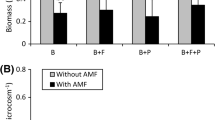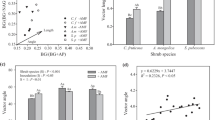Abstract
This study was carried out in a semiarid degraded area to assess the effectiveness of mycorrhizal inoculation with a mixture of native arbuscular mycorrhizal (AM) fungi or an allochthonous AM fungus (Glomus claroideum), on the establishment of Olea europaea subsp. sylvestris L. and Retama sphaerocarpa (L.) Boissier in this area. Associated changes in the soil microbiological properties and aggregate stability related to these AM inocula were also recorded. Eighteen months after planting, G. claroideum had increased available P in the rhizosphere of both shrub species. In general, both inoculation treatments increased water-soluble C and water-soluble and total carbohydrates, G. claroideum being the most effective inoculum, particularly in R. sphaerocarpa. The mixture of native AM fungi was the most effective treatment for increasing the aggregate stability of R. sphaerocarpa soil, while that of O. europaea was increased only by G. claroideum. Increased (dehydrogenase, urease, protease-BAA, acid phosphatase and β-glucosidase) enzyme activities, in particular of dehydrogenase and acid phosphatase, were recorded in the rhizosphere of both mycorrhizal shrub species. The mixture of native AM fungi was the most effective treatment for stimulating the growth of O. europaea and R. sphaerocarpa (11.6-fold and 3.3-fold, respectively, greater than control plants). The establishment of mycorrhizal shrub species favoured the reactivation of soil microbial activity, which was linked to an increase in aggregate stability.



Similar content being viewed by others
References
Augé RM (2001) Water relations, drought and vesicular-arbuscular mycorrhizal symbiosis. Mycorrhiza 11:3–42
Azcón-Aguilar C, Palenzuela J, Roldán A, Bautista S, Vallejo R, Barea JM (2003) Analysis of the mycorrhizal potential in the rhizosphere of representative plant species from desertification-threatened Mediterranean shrublands. Appl Soil Ecol 22:29–37
Barea JM, Azcón R, Azcón-Aguilar C (1992) Vesicular-arbuscular mycorrhizal fungi in nitrogen-fixing systems. Method Microbiol 24:391–416
Bearden BN, Petersen L (2000) Influence of arbuscular mycorrhizal fungi on soil structure and aggregate stability of vertisols. Plant Soil 218:173–183
Benefield CB, Howard PJA, Howard DM (1977) The estimation of dehydrogenase activity in soil. Soil Biol Biochem 9:67–70
Brink RH, Dubar P, Lynch DL (1960) Measurement of carbohydrates in soil hydrolysates with anthrone. Soil Sci 89:157–166
Caravaca F, Barea JM, Figueroa D, Roldán A (2002) Assessing the effectiveness of mycorrhizal inoculation and soil compost addition for reafforestation with Olea europaea subsp. sylvestris through changes in soil biological and physical parameters. Appl Soil Ecol 20:107–118
Caravaca F, Alguacil MM, Figueroa D, Barea JM, Roldán A (2003a) Re-establishment of Retama sphaerocarpa as a target species for reclamation of soil physical and biological properties in a semi-arid Mediterranean area. For Ecol Manage 182:49–58
Caravaca F, Barea JM, Palenzuela J, Figueroa D, Alguacil MM, Roldán A (2003b) Establishment of shrub species in a degraded semiarid site after inoculation with native or allochthonous arbuscular mycorrhizal fungi. Appl Soil Ecol 22:103–111
Caravaca F, Figueroa D, Barea JM, Azcón-Aguilar C, Palenzuela J, Roldán A (2003c) The role of relict vegetation in maintaining physical, chemical and biological properties in an abandoned Stipa-grass agroecosystem. Arid Land Res Manage 17:103–111
Carrillo-García A, Luz JL, Bashan Y, Bethlenfalvay GJ (1999) Nurse plants, mycorrhizae, and plant establishment in a disturbed area of the Sonoran desert. Restor Ecol 7:321–335
Ceccanti B, Pezzarossa B, Gallardo-Lancho FJ, Masciandaro G (1994) Bio-tests as markers of soil utilization and fertility. Geomicrobiol J 11:309–316
Doran JW, Parkins TB (1994) Defining and assessing soil quality. In: Doran JW, Coleman DC, Bezdicek DF, Stewart BA (eds) Defining soil quality for a sustainable environment. Soil Science Society of America, Madison, Wis., pp 3–21
FAO (1998) Soil map of the world: revised legend. Food Agriculture Organization of the United Nations, p 119
Ghani A, Dexter M, Perrott KW (2003) Hot-water extractable carbon in soils: a sensitive measurement for determining impacts of fertilisation, grazing and cultivation. Soil Biol Biochem 35:1231–1243
Giovannetti M, Mosse B (1980) An evaluation of techniques for measuring vesicular-arbuscular mycorrhizal infection in roots. New Phytol 84:489–499
Herrera MA, Salamanca CP, Barea JM (1993) Inoculation of woody legumes with selected arbuscular mycorrhizal fungi and rhizobia to recover desertified Mediterranean ecosystems. Appl Environ Microbiol 59:129–133
Jeffries P, Barea JM (2000) Arbuscular mycorrhiza—a key component of sustainable plant-soil ecosystems. In: Hock B (ed) The Mycota. IX. Fungal associations. Springer, Berlin Heidelberg New York, pp 95–113
Jeffries P, Gianinazzi S, Perotto S, Turnau K, Barea JM (2003) The contribution of arbuscular mycorrhizal fungi in sustainable maintenance of plant health and soil fertility. Biol Fertil Soils 37:1–16
Joner EJ, van Aarle IM, Vosatka M (2000) Phosphatase activity of extra-radical arbuscular mycorrhizal hyphae: a review. Plant Soil 226:199–210
Ladd JN, Butler JH (1972) Short-term assays of soil proteolytic enzyme activities using proteins and dipeptide derivative as substrates. Soil Biol Biochem 4:19–30
Lax A, Díaz E, Castillo V, Albaladejo J (1994) Reclamation of physical and chemical properties of a salinized soil by organic amendment. Arid Soil Res Rehabilit 8:9–17
Maestre FT, Cortina J, Bautista S, Bellot J (2003) Does Pinus halepensis facilitate the establishment of shrubs in Mediterranean semi-arid afforestation? For Ecol Manage 176:147–160
Marschner P, Crowley DE, Higashi M (1997) Root exudation and physiological status of a root-colonizing fluorescent pseudomonad in mycorrhizal and non-mycorrhizal pepper (Capsicum annuum L). Plant Soil 189:11–20
Moro MJ, Pugnaire FI, Haase P, Puigdefábregas J (1997) Effect of the canopy of Retama sphaerocarpa on its understorey in a semiarid environment. Funct Ecol 11:425–431
Murphy J, Riley JP (1962) A modified single solution method for determination of phosphate in natural waters. Anal Chim Acta 27:31–36
Nannipieri P (1994) The potential use of soil enzymes as indicators of productivity, sustainability and pollution. In: Pankhurst CE, Doube BM, Gupta VVSR, Grace PR (eds) Soil biota: management in sustainable farming systems. CSIRO, Australia, pp 238–244
Naseby DC, Lynch JM (1997) Rhizosphere soil enzymes as indicators of perturbation caused by a genetically modified strain of Pseudomonas fluorescens on wheat seed. Soil Biol Biochem 29:1353–1362
Phillips JM, Hayman DS (1970) Improved procedures for clearing roots and staining parasitic and vesicular-arbuscular mycorrhizal fungi for rapid assessment of infection. Trans Br Mycol Soc 55:158–161
Puget P, Angers DA, Chenu C (1999) Nature of carbohydrates associated with water-stable aggregates of two cultivated soils. Soil Biol Biochem 31:55–63
Requena N, Pérez-Solis E, Azcón-Aguilar C, Jeffries P, Barea JM (2001) Management of indigenous plant-microbe symbioses aids restoration of desertified ecosystems. Appl Environ Microbiol 67:495–498
Roldán A, Díaz G, Albaladejo J (1992) Effect of VAM-fungal inoculation on growth and phosphorus uptake of two Hedysarum species in a Xeric Torriorthent soil from southeast Spain. Arid Soil Res Rehabilit 6:33–39
Roldán A, García-Orenes F, Lax A (1994) An incubation experiment to determine factors involving aggregation changes in an arid soil receiving urban refuse. Soil Biol Biochem 26:1699–1707
Sims JR, Haby VA (1971) Simplified colorimetric determination of soil organic matter. Soil Sci 112:137–141
Smith SE, Read DJ (1997) Mycorrhizal symbiosis. Academic, San Diego
Tabatabai MA (1982) Soil enzymes. In: Page AL, Miller EM, Keeney DR (eds) Methods of soil analysis. American Society of Agronomy and Soil Science Society of America, Madison, Wis., pp 501–538
Tabatabai MA, Bremner JM (1969) Use of p-nitrophenol phosphate in assay of soil phosphatase activity. Soil Biol Biochem 1:301–307
Tabatabai MA, Bremner JM (1972) Assay of urease activity in soil. Soil Biol Biochem 30:1333–1341
Wamberg C, Christensen S, Jakobsen I, Müller AK, Sørensen SJ (2003) The mycorrhizal fungus (Glomus intraradices) affects microbial activity in the rhizosphere of pea plants (Pisum sativum). Soil Biol Biochem 35:1349–1357
Yeomans JC, Bremner JM (1988) A rapid and precise method for routine determination of organic carbon in soil. Commun Soil Sci Plant Anal 19:1467–1476
Acknowledgements
This research was supported by the EC + CICYT co-financed FEDER programme (1FD97-0507 FOREST). We acknowledge the technical support of Paisajes del Sur and TRAGSA.
Author information
Authors and Affiliations
Corresponding author
Rights and permissions
About this article
Cite this article
Alguacil, M.M., Caravaca, F. & Roldán, A. Changes in rhizosphere microbial activity mediated by native or allochthonous AM fungi in the reafforestation of a Mediterranean degraded environment. Biol Fertil Soils 41, 59–68 (2005). https://doi.org/10.1007/s00374-004-0788-5
Received:
Revised:
Accepted:
Published:
Issue Date:
DOI: https://doi.org/10.1007/s00374-004-0788-5




